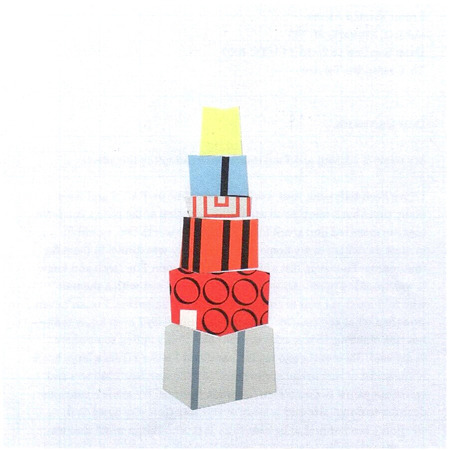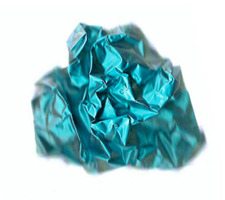The Business of Art: The Fine-Art Adoption Network
Audra Wolowiec, pocket cloud. Metallic film.
Last year, Class 808 at M.S. 131 in Manhattan’s Chinatown wrote to artist Audra Wolowiec asking if they might “adopt” her uneditioned multiple, pocket cloud, a square of recycled metallic film, sky blue on one side and silver on the other, with attached instructions to crumple the film into a ball, “place in pocket,” and “open when needed.” In their joint letter to Wolowiec, the seventh and eighth graders wrote that they liked that the piece was portable and smooth and would “feel like we had a real cloud with us.” Charmed by the letter, Wolowiec gave each classmate a pocket cloud to customize and look after.
The exchange between Wolowiec and Class 808 was made possible by the Fine Art Adoption Network (FAAN), a website where artists post works they are willing to donate to whomever makes the most compelling case for ownership. FAAN visitors can browse available artworks by artist name and discipline and, if they see a piece they would like to own, email the artist through the site to explain why the work resonates with them. Artists choose which, if any, of the would-be adopters will receive their work, and can ask as many questions as they wish before making their choice.
Adam Simon conceived of FAAN when faced with a problem familiar to many visual artists: what to do with old, unsold artworks. Most artists, regardless of their degree of commercial success, create more work than they can sell or exhibit. It occurred to Simon that “by assigning works either enormous value or none at all, the art market makes a lot of significant art invisible.” He envisioned FAAN as an alternative to the conventional art market, connecting artworks “with people for whom the works will have great value.” Simon pitched his project to Art in General’s New Commissions Program in 2005; it was accepted, and launched in 2006.
Simon’s name for the project, the Fine Art Adoption Network, is a reminder that for some artists, completing an artwork is like bearing a child: the completed work has a “life” of its own, and is precious to and representative of its maker. The choice of the word “adoption” implies that the acquired work will be like a new member of the adopters’ family; it affirms the specialness of the work and demands a level of respect and commitment from potential adopters for the works they request.

Austin Thomas, Building Blocks (2004). Collage on graph paper.
Initial email to Austin Thomas from the successful adopter of Building Blocks:
Dear Austin!
Hi there; I love this drawing. It’s even more compelling that you decided to compose it on graph paper; literally, boxes upon boxes. But, despite it’s geometric precision, it is still whimsical (don’t take this as offense, but I feel like it could be an illustration for, say, Breakfast at Tiffany’s or something). What’s also dynamic about it is that you drew the boxes sort of on an angle, so the inherent flatness and 2-dimensionality is overcome. In short, I’m drawn to your drawing! I’d love to adopt it if it is still available.
While I have equal amounts of wall space to cover in both my apartment and my office, I’d probably opt for the office, because then I’d get to look at it all day (and other people will get to see it). I work for a rare book dealer in Manhattan who also collects art, so it’d fit in nicely here. Also, this FAAN program is so great – I am a grad student (so I won’t be able to afford original art anytime soon). Anyway, I hope we can discuss this!
Regards,
Jessica
In Lewis Hyde’s seminal book, The Gift, a touchstone for the curators at Art in General who commissioned and helped shape FAAN, Hyde suggests that the isolation and sense of entitlement that accompany market exchange can diminish, and even destroy, art. To be art, Hyde writes, not only must a work be an emanation of its maker’s gift, e.g., a gift of intuition or inspiration, but the audience must also feel the gift it carries. “Where there is no gift there is no art,” he writes.
For the many people who would like to own original artworks but can’t afford gallery prices—and even those who can—FAAN is clearly a tremendous resource. What is less obvious is what would motivate artists to give works away for free to strangers, especially given how difficult it is for most artists to make a living. Many of the works on FAAN are new and do not represent a storage problem. In fact, some artists create works with the intention of giving them away on FAAN.
FAAN rewards participating artists in a number of ways, one of which is the experience of receiving sincere emails from people around the world who see value in their art and want to engage them in conversation about it. The conventional art market rarely offers the affirmation and connection with one’s audience that this experience provides. On the contrary, the art world can be isolating and random in its feedback: hard work may or may not be valued, and all the press in the world might not translate into sales. Artist and Program Officer of NYFA Learning Felicity Hoganalmost quit the art world because of these challenges. Then she learned about FAAN and, on a whim, decided to post some old works on the site. The notes Hogan received from people who felt moved to tell her how much her paintings meant to them encouraged her to keep at her studio practice.

Fawn Krieger, Trophy (11), Sculpture
Initial email to Fawn Krieger from the successful adopter of Trophy (11):
Dear Fawn Krieger,
I am a kid and I have alot of trophies in my room. I think that this cool looking trophy would go great with all those trophies. I also like how it is not of a specific thing so I can use my imagination to picure what sport or event that golden part is carved into. Thanks–Ian (from my mom’s e-mail)
P.S. Please.
Some FAAN artists have gladly given away work to the first person who asked, trusting that whoever takes the time to think about and articulate why they want to live with a piece must be genuine in their request. Other artists are more selective, holding out for the right match. Amy Sillman, who shows regularly in New York and Los Angeles, knew that she wanted to give her work to someone outside these art market capitals, perhaps to a “librarian in Kansas.” Sillman received scores of requests for her two gouaches, including a request from a museum, but indicated that her goal in participating in FAAN was “to get [contemporary] art to people who wouldn’t have it otherwise.” Ultimately, she gave one work to an Arkansan and the other to a New York-based artist (she liked his note and that he worked for the nonprofit Artists Unite).
Naturally, FAAN attracts some savvy collectors, but thanks to wide-ranging press and partnerships with nonprofit arts organizations across the country, the site receives traffic from a diverse group of would-be adopters. Simon sees special value in donating original artwork to first-time art owners, especially to those who would otherwise not be able to afford an original artwork. In interviews, he often cites Pierre Bourdieu’s book Distinction, which argues that upper-class children gain an early familiarity with art and aesthetics that helps ensure their class status as adults. Receiving art education in school cannot approximate the “cultural inheritance” of growing up in a home with original artwork, Bourdieu asserts. Donating artwork to first-time art owners can have a profound impact on the work’s adopters, introducing them to the pleasures of living with art, and perhaps inspiring them to create art themselves.
Now four years old, FAAN has enabled several hundred art adoptions, which are cataloged on a page of the site called “The Adoptions.” The site is still in beta testing, but Simon has enlisted the help of two web designers for an overhaul, which will include a new functionality that allows FAAN participants to stay in touch with one another. Simon’s hope is that the Network will continue to expand and become global. If you’re an artist and would like to put work up for adoption on FAAN, or if you’re interested in adopting work, click here.
Daniel Wentworth is a writer and Editorial Intern at NYFA Current. He holds a B.A. in Art History from Earlham College and has worked at The Jewish Museum and the BRICRotunda Gallery.




